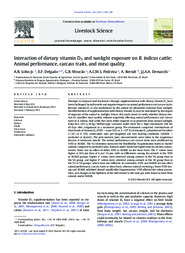Interaction of dietary vitamin D3 and sunlight exposure on B. indicus cattle: animal performance, carcass traits, and meat quality.
Interaction of dietary vitamin D3 and sunlight exposure on B. indicus cattle: animal performance, carcass traits, and meat quality.
Author(s): LOBO-JR, A. R.; DELGADO, E. F.; MOURÃO, G. B.; PEDREIRA, A. C. M. S.; BERNDT, A.; DEMARCHI, J. J. A. A.
Summary: Attempts to improve beef tenderness through supplementation with dietary vitamin D3 have been challenged by null results and negative impacts on animal performance and carcass traits. Because vitamin D3 is also synthesised by the animal via ultraviolet radiation from sunlight, the effectiveness of supplementation with dietary vitamin D3 may be modulated by the degree of exposure of the animal to sunlight. Hence, this work aimed to verify whether dietary vitamin D3 modifies meat quality without negatively affecting animal performance and carcass traits in B. indicus beef cattle that were either exposed to or protected from natural sunlight. Forty-two (411±38 kg) Nellore-type castrated males were fed a high-concentrate diet for 45 days after assignment to a treatment group. The treatments comprised combinations of three levels of vitamin D3 [ViTD ? none (V0) or 2×106 IU of vitamin D3 administered for either 2 (V2) or 8 (V8) consecutive days pre-slaughter] and two shading conditions (SHADE ? unshaded or shaded). The post-mortem (pm) measurements were taken in the Longissimus thoracis et lumborum muscle. The animal performance and carcass traits were unaffected by ViTD or SHADE. The V2 treatment increased the Myofibrillar Fragmentation Index in shaded animals compared to unshaded ones. Animals under shade had higher muscle calcium concentration. There was no effect of either ViTD or SHADE on the shear force. The L* values were higher at 24 h pm than at 0 and 1 h pm, with no differences among the animals in the ViTD or SHADE groups. Higher a* values were observed among animals in the V8 group than in the V0 group, and higher b* values were observed among animals in the V8 group than in the V2 or V0 groups, which were not different. In conclusion, ViTD and SHADE did not affect animal performance, carcass traits or shear force, whereas animals receiving a lower ViTD dosage and SHADE exhibited altered myofibrillar fragmentation. ViTD affected the colour parameters, and changes in the lightness of the beef related to the time pm were found in meat from animals under SHADE.
Publication year: 2012
Types of publication: Journal article
Keywords: Nellore, Shear force, Tenderness, calcium, shade, ultraviolet radiation
Observation
Some of Embrapa's publications are published as ePub files. To read them, use or download one of the following free software options to your computer or mobile device. Android: Google Play Books; IOS: iBooks; Windows and Linux: Calibre.
Access other publications
Access the Agricultural Research Database (BDPA) to consult Embrapa's full library collection and records.
Visit Embrapa Bookstore to purchase books and other publications sold by Embrapa.

